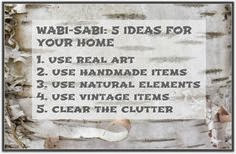art.


objects found in debris, the peeling layers of wallpaper in old homes,

(flawed beauty) can also relate directly to your living space. The
Japanese world view/aesthetic of wabi sabi acknowledges three
simple realities: nothing lasts, nothing is finished, and nothing is
perfect.
authenticity. When you look for authentic furniture and objects for your home you will rarely find them in big box stores. Natural materials predominate in wabi sabi homes: paper, aged wood, linens, cottons, etc. Look for anything that celebrates the marks of time , weather, and the effects of loving use.

Characteristics
of wabi-sabi include: asymmetry, asperity (roughness, irregularity),
simplicity, economy, austerity, and appreciation of the integrity of
natural objects and processes. Look for: natural flawed beauty, patina, handmade, irregularity, bareness. How refreshing!


feel colour is not exclusive of this aesthetic. Here’s a good
example that has all the characteristics noted above. The marks of time are evident, even more so on colour.



The wood console table is a hint of wabi sabi against the glass. The space is simple and tranquil.

I love the imprefection of this countertop against the modern, pristine cabinets. Am I the only person who craves warmth in countertops? Imagine the difference if this island were finished in granite.

Lots of natural materials, simplicity and economy is line and adornment, and a focus on the handmade.



And a lesson we can all learn from Wabi Sabi….you can also interpret
it in a much looser fashion to accept what you have as beautiful and to
live with only what you need.
The post Is there beauty in imperfection? appeared first on Decor Pur.















0 comments:
Post a Comment